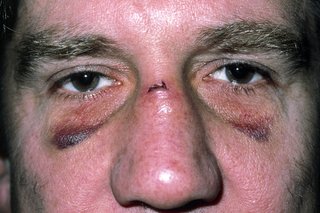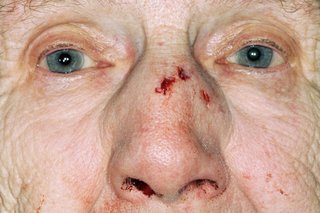A broken nose usually heals on its own within 3 weeks. Get medical help if it's not getting better or your nose has changed shape.
Check if it's a broken nose
Symptoms of a broken nose include:
- pain, swelling and bruising
- a crunching or crackling sound when you touch your nose
- difficulty breathing through your nose – it might feel blocked
- your nose changing shape – for example, it's not as straight as before


How to treat a broken nose yourself
You can usually treat a broken nose yourself. It should start getting better within 3 days and be fully healed within 3 weeks.
Do
-
hold an ice pack (or bag of frozen peas) wrapped in a tea towel on your nose for up to 15 minutes, several times a day
-
take paracetamol to relieve pain
-
treat nosebleeds by sitting or standing upright and leaning forward – if possible, pinch your nose above the nostrils for up to 15 minutes
-
keep your head upright when lying in bed by adding more pillows – this will help to reduce swelling
-
treat minor cuts and grazes by stopping any bleeding, cleaning the wound and covering it with a plaster or dressing
Don’t
-
do not try to straighten your nose yourself if it's changed shape – get help from 111 online, go to a minor injuries unit or see a GP
-
do not wear glasses until the swelling has gone down, unless you need them
-
do not pick or blow your nose until it's healed
-
do not do strenuous exercise for the first 2 weeks
-
do not play sports for at least 6 weeks if there's a chance your face might be hit
If you have a small cut on your nose, find out how to treat minor cuts and grazes.
Non-urgent advice: Go to a minor injuries unit or see a GP if:
- your nose is crooked (not straight) after the injury
- the swelling has not started to go down after 3 days
- painkillers are not helping
- you're still finding it difficult to breathe through your nose after the swelling has gone
- you're having regular nosebleeds
- you have a very high temperature (or you feel hot and shivery)
Immediate action required: Call 999 or go to A&E if:
You have a broken nose and:
- a nosebleed that will not stop
- a large cut or open wound on your nose or face, or something in the wound, such as glass
- clear, watery fluid trickling from your nose – this could be a sign of a serious head injury
- a severe headache with blurred or double vision
- eye pain and double vision
- neck pain or a stiff neck with numbness or tingling in your arms
- a purple swelling inside your nose – it may be painful or block your breathing
- other symptoms of a severe head injury – such as vomiting, collapsing (passing out) or difficulty speaking
Treatment for a broken nose
A GP might prescribe stronger painkillers if paracetamol is not helping with pain caused by a broken nose.
If you have a severe broken nose or it's changed shape, you may be referred to a specialist in hospital for assessment and treatment.
If your nose has changed shape
A doctor in hospital may be able to make your nose straighter using a procedure called manipulation.
You might have to go home and wait for the swelling to go down first, but the procedure should be done within 3 weeks of you breaking your nose, before the bones start to set.
Manipulation is done using local anaesthetic so that your nose is numbed. It does not always make your nose look exactly the same as it was before, but it often helps.
If you have a large wound
The wound will usually be cleaned and sealed with stitches or strips in hospital.
Page last reviewed: 17 August 2023
Next review due: 17 August 2026